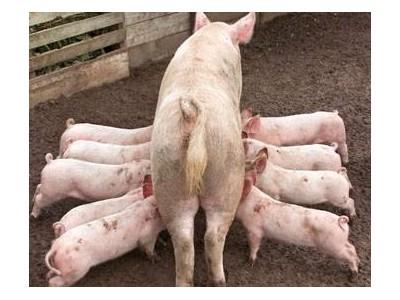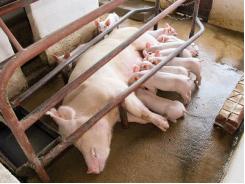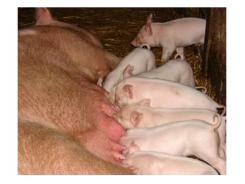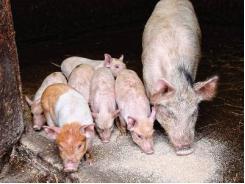Targets for weaned piglet feed intake

Pre-weaning performance can be used as an ideal target for the first week post-weaning under commercial conditions.
How much should a weaned piglet eat the first week post-weaning? This highly debated topic is answered from a commercial point of view, balancing potential with practical limitations.
No nutritionist could disagree that piglets never eat enough to grow to their full genetic potential, at least during the first few weeks post-weaning. This is because of the myriad of overwhelming challenges piglets encounter right after weaning. Among them, it suffices to notice the early weaning compared to natural weaning, social and environmental stress, immunological challenges and unfamiliarity with post-weaning feeding systems and diets.
Weaned piglet nutritional challenges
In terms of nutrition, weaned piglets are required not only to recognize an unusual diet as nourishment, but also to decide when and how much to eat. At the same time, they must distinguish thirst from hunger and learn to satisfy these needs via separate media, as water is no longer part of their feed as it was in sow's milk.
A higher growth rate and feed intake usually result from increasing weaning age and by providing liquid diets and creep feeding. Yet, these practices are not always practical, cost-effective, or even well-known
Post-weaning depressed feed intake is invariably associated with gastrointestinal tract damage and allergenic reactions to antigens from legumes (soybeans), which lead to nutritional diarrhea followed by bacterial disease complications. On the other hand, when starving pigs suddenly start eating (usually between the second and fifth day post-weaning) the already challenged digestive system is overloaded with partially digested feed that promotes microbial proliferation and diarrhea.
Thus, abnormal feed intake patterns always are associated with digestive upsets post-weaning. Furthermore, with a deteriorating health status temperature requirements increase, morbidity and mortality intensify and turnover of expensive nursery facilities is slowed down.
The impact of early high feed intake
The major impact of post-weaning anorexia, however, is growth depression, because feed intake drives growth in a linear fashion at this age. For example, studies from the Ohio State University indicated that for every 0.1 kg extra feed per day during the first week post-weaning, body weight increases about 1.5 kg at the end of the fourth week post-weaning.
High feed intake during the first week post-weaning not only promotes growth and health during the nursery phase, but it also enhances growth performance during the entire grow-out period. In studies conducted at Kansas State University, pigs that maintained or lost weight during the first week post-weaning required 10 extra days to reach market weight, compared with pigs that gained about 0.25 kg/day during the same period.
Pre-weaning performance as index
It is currently accepted that weaned pigs experience minimal nutritional challenges, if they are able to sustain their pre-weaning growth rates during the first week post-weaning. Typical growth rates of suckling pigs range from 200 g/day for conventional genotypes to 300 g/day for modern genotypes. Growth rate during the first week of lactation is highly variable and increases from about 50 to 200 g/day, depending on sow performance and environmental conditions.
During the rest of the lactation period, piglet growth plateaus at 200-300 g/day, indicating the inadequacy of milk supply to cover the increasing needs of suckling piglets. Therefore, an average figure of 250 g/day often is used as a benchmark for pre-weaning growth rate.
To illustrate how much feed must be consumed to maintain a pre-weaning growth rate of 250 g/day post-weaning, consider the following five assumptions:
1. Energy requirements for maintenance are 0.44 MJ ME per kg0.75
2. Energy requirements for protein and lipid gain are 44 and 52 MJ ME per kg
3. A 21-day-old piglet weighs about 6.5 kg at weaning
4. Weight gain is 16 percent protein with 1:1 lipid to protein ratio
5. A high-quality post-weaning diet contains 16.5 MJ ME/kg and is balanced for all nutrients
Based on the above assumptions, it is calculated that 1.8 MJ ME are required for maintenance and 3.8 MJ ME for growth, for a total of 5.6 MJ ME per day. Thus, if pigs were not to catabolize body fat for maintenance, they would need to consume at least 110 g feed per day to sustain body weight and composition. For growth, another 230 g feed would be required to sustain a growth target of 250 g/day. Total feed intake would have to be at least 340 g/day - a figure rather impossible under current commercial practices.
Practical considerations
These calculations suggest an efficiency of feed utilization of 1.36 (feed/gain) or about 0.74 (gain/feed). In practice, however, these figures approach unity (1.0) because pigs actually lose fat and gain protein and water during the first week post-weaning. The above calculations, assume that body composition remains unaffected. Figure 1 offers a rough estimate of feed intake required to sustain different growth rates post-weaning.
In reality, most piglets rarely consume more than 200 g/day of feed on average during the first week post-weaning. In fact, feed intake is usually below 100 g during the first couple days, and individual piglets may starve completely for as long as five to seven days.
Feed intake reaches 350 g/day usually during the second week post-weaning. As young pigs do not adjust feed intake to maintain constant energy intake, in contrast to more mature pigs, it is imperative they have access to high-fat diets to ensure maximal energy intake. Obviously, more feed is required to sustain growth if dietary energy concentration is reduced as shown in Figure 2.
What is the real genetic potential?
Even if pigs consumed 350 g/day of a high-quality feed, there would still be room for improvement because young pigs have a rather untapped potential for growth. The fastest growth rates in young pigs were recorded by Hodge (1974), who offered reconstituted cow's milk (20 percent DM) for ad libitum consumption to pigs from 10 to 50 days of age.
At 30 days of age, these pigs reached 15 kg with an astonishing growth rate of almost 600 g/day. Most modern pigs would still struggle to adapt to post-weaning diets at this age and are not expected to weigh more than 9 to 10 kg at best. At 50 days of age, pigs in the above trial reached 32 kg with an unbelievable overall growth rate above 700 g/day.
Again, all modern pigs receiving dry diets would not weigh more than 22-25 kg at the same age; and this would be the best-case scenario. More recently, a research report from Cornell University indicated that three-week-old pigs can easily reach 10 kg body weight under non-limiting conditions (in most commercial operations pigs rarely exceed 7 kg at this age). These results indicate not only the great potential for growth in young pigs, but also the impediment in growth imposed by rearing pigs on sows.

More feed is required to sustain growth, if dietary energy concentration is reduced.

A rough estimate of feed intake required to sustain different growth rates post-weaning.
Ioannis Mavromichalis, Ph.D., is Nutrition Editor for WATTAgNet and Editor-in-Chief of Pig International.
Related news
Tools

Phối trộn thức ăn chăn nuôi

Pha dung dịch thủy canh

Định mức cho tôm ăn

Phối trộn phân bón NPK

Xác định tỷ lệ tôm sống

Chuyển đổi đơn vị phân bón

Xác định công suất sục khí

Chuyển đổi đơn vị tôm

Tính diện tích nhà kính

Tính thể tích ao




 Why protein requirements differ for diseased livestock
Why protein requirements differ for diseased livestock  8 questions to ask when purchasing piglet feeds
8 questions to ask when purchasing piglet feeds